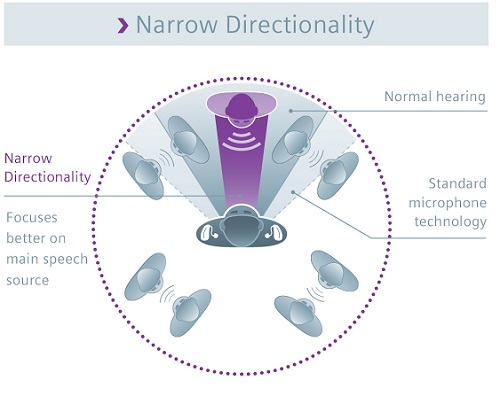Siemens Introduces binax, the Next Generation of BestSound Technology
Carolyn Smaka: Tell me about binax, your newest product platform unveiled at EUHA.

Alina Urdaneta: Siemens binax is the next generation of BestSound Technology. It was only 18 months ago that we launched the very successful micon platform. micon continues to be extremely well-received and customers have told us that they did not see how it could get any better.
binax emulates the effects of binaural hearing and brings these advantages back to hearing aid wearers. It leverages natural binaural functions like binaural redundancy, binaural squelch, and binaural directed listening. Just like the brain, this technology platform uses sound input from both ears—or in this case both instruments. binax hearing instruments share not only volume and program changes, but they actually exchange audio signals. So in a bilateral fitting, you have signals coming from four microphones on each side, for a total of eight. We call this a virtual eight-microphone network, which allows a heightened sensitivity of the acoustic environment. The result is what we call High Definition Sound Resolution (HDSR), which delivers better clarity, richness of sound, localization, speech recognition and spatial awareness—all without compromising battery life.
With binax, our engineers drew on the natural benefits of binaural hearing and the healthy auditory system. Our e2e wireless technology, for which we were recently awarded a German National Prize in Science and Technology, is now in its third generation. In the past, e2e wireless was like a bridge between the hearing aids that transmitted volume and program information. Now, e2e wireless 3.0 is like a highway with four channels going in one direction and four channels coming in the other direction. It can exchange 1,000 times more data per second between hearing aids compared to e2e wireless 2.0.
For the first time ever, binax wearers can understand speech in demanding listening environments better than people with normal hearing in the same environment. That is a bold statement and there are clinical studies that back it up. We are also introducing a new benchmark of convenience for wearers.
Eric will provide more details on this exciting new technology.
Carolyn: Eric, can you describe the studies that Alina mentioned claiming that binax provides better performance in noisy environments than people with normal hearing?

Eric Branda: One study was conducted at University of Northern Colorado (UNC) and one was done at Oldenburg Horzentrum in Germany. These studies showed that there was a 2.9 dB improvement in speech reception thresholds using the Hearing In Noise Test (HINT) for subjects with mild to moderate hearing loss wearing binax technology with the directional microphones activated, as compared to people with normal hearing. That correlates to approximately a 25% advantage in speech understanding.
The binax feature responsible for this improved performance is Narrow Directionality. Narrow Directionality uses a much more focused beam with directional beamforming, utilizing that virtual eight-microphone array that Alina mentioned. With two mics on the left side and two mics on the right side, binax takes the audio data from the mic on the right side and transfers that to the left side, so each instrument is essentially using four microphones. As a result, the beam is very precise in focusing on the signal or person that the wearer wants to hear. It not only suppresses sounds from behind the wearer, but also suppresses sounds at angles outside of the very narrow beam, and it does all this automatically. This is very effective in places with diffuse noise like cocktail parties and restaurants.

Spatial Speech Focus is another important feature of binax. In micon we introduced Speech Focus, which enabled the directional microphones to focus on the front or the rear of the wearer. Because binax has a wireless exchange of data between the hearing aids, we can now get true directionality to the left and the right sides, as well. In a car, for example, binax hearing aids can automatically detect the car situation and adapt accordingly. If I’m driving and wearing binax hearing aids, I do not need to turn my head to my passenger to get directions; I can keep my eyes focused on the road and still hear my passenger. The hearing aid mics automatically engage a directional mode focusing to that speaker on my right so I can get the information I need without having to turn my head. You can also use this feature in what we call a stroll program. If I’m walking along the street, and have a speaking companion next to me, I can still watch where I am walking while I am engaged in conversation. It provides true directivity.
Carolyn: What are some of the other new features enabled by the shared audio signals in binax instruments?
Eric: The eWindscreen Binaural is another automatic feature – it takes wind noise reduction to the next level. When wind noise is detected, binax identifies it, and reduces gain in any of the 48 channels with wind noise. Now, if noise is only on one side, we can take the audio data from the “clean” side without wind noise and transfer it over to the other ear. It reduces the signal on the troublesome or windy side and then replaces it with a clean signal from the opposite side. Our algorithms actually account for level and timing differences between the left and right sides so that we still know what is on the left and what is on the right. It is highly intelligent and makes it easier for wearers to perform in windy environments.
Another new feature is the Spatial Configurator. While the automatic processing in these instruments is state-of-the-art, we are also cognizant of the individual wearer who may want some “directionality on demand.” Automatic processing may be preferred in 95% of situations, but there might be a few situations where a wearer may want to take a little more control of what they want to hear. The Spatial Configurator has two components: span and direction. Span will control the width of the narrow directional beam. That beam will automatically widen or narrow depending on the environment, but span will enable the wearer to go to a wider beam to pick up a little more of the area around them. Or, maybe the wearer wants a narrower beam in order to completely focus on one person speaking with them.
The Spatial Configurator direction controls the Spatial Speech Focus. Let’s say I am speaking to someone across the table from me, but I hear someone to the right of me mention my name. I could use the Spatial Configurator direction to have my directional mics focus on the right to hear the person to my right. The Spatial Configurator gives the wearer the opportunity to override the automatic functionality and be very specific on who or what they want to listen to.
Carolyn: Speaking of wearer control, Alina mentioned apps, which I assume enable the wearer additional functionality.
Eric: Yes, binax gives wearers even more independence via their smart phones. The touchControl app is an acoustic app. It does not use wireless communication; it uses acoustic signals, or very high-pitched tones that most people will not hear, but the hearing aids will pick them up. Now, any binax hearing aids, including nonwireless hearing aids like Ace, can take advantage of this feature and use any smart phone as a basic remote control. They can change programs, change volume, and make adjustments to the frequency response.
The app is available on the Apple store as well as Google Play. It is a free download for the wearer.
Carolyn: Is there a remote control device compatible with binax instruments?
Eric: binax instruments work with easyTek, our next generation of a wireless streaming device. easyTek is primarily one button operation. It does have a volume adjustment on the side but essentially there is one central button used to change programs, accept phone calls, and change to different transmitters. It is very intuitive. A phone call comes in, the wearer presses the button and takes the phone call. Two quick presses and they can go right to their TV transmitter. It is very easy. It can be paired with two Bluetooth phones at the same time, as many people are not limited to only one phone. It can be paired with any of our transmitters or our VoiceLink companion microphone. It can be worn under the clothes, which does not interfere with microphone performance or telephone calls, and helps keep it nice and discreet. Both men and women have had very favorable responses to the design.
easyTek has direct audio input so it can be used with FM. It also has a micro USB for charging. We are also happy to say that it is pacemaker friendly. Because of the distribution of the power in the antenna, easyTek can be comfortably worn with a pacemaker, which is very important for many people wearing hearing aids. It is a Made For iPhone device that also works with Android platforms. The professional does not have to program it in any way. In fact, all that has to be done prior to the first use is a simple pairing process. You simply hold the center button on easyTek for a few seconds, close your instruments’ battery doors, they all find each other, and your pairing is complete. It is just that simple.
We also introduced the easyTek app. Here is where an iPhone or Android device can become that main control for binax hearing aids. It enables program change, volume change, and adjustments for treble and bass control. It also provides access to the Spatial Configurator via the easyTek wireless streaming device. It is extremely intuitive. Keep in mind that wearers may not always have their easyTek device with them. In those cases, they won’t have access to the Spatial Configurator via the easyTek app, but they can still use the app to change volume, program, and treble/bass on their instruments.
Carolyn: What products are available on the binax platform?
Eric: We have four Receiver in Canal (RIC) instruments available at the 7bx and 5bx performance levels: Pure binax, Carat binax, Carat A binax and Ace binax.
Pure uses a 312 battery, and a similar proven and well-accepted housing design as the Pure micon. It is comparable to size 10 RICs on the market from other companies. It is rechargeable, fully featured, and includes a T-coil, and full wireless connectivity.
The Carat binax and the Carat A binax use size 13 batteries, but the housing is very comparable to the 312 housing. There is very little difference in the sizes, but the 13 battery enables more battery capacity and the option of a stronger receiver that provides up to 75 dB of gain. The Carat binax is rechargeable and has wireless connectivity. In contrast, the Carat A is nonrechargeable but has the option for a battery door with direct audio input. It is exciting to offer a RIC device with direct audio input (DAI) capability. This is perfect for those people that prefer a really discrete DAI option. It also has wireless connectivity.
Ace binax uses a size 10 battery. It is very small and discrete, and the touchControl app provides remote control capabilities. It is really attractive, and very appealing both in the hand and on the ear.
Carolyn: Are binax instruments available now?
Eric: Yes! Our official launch date was October 27th.
Carolyn: Thanks Alina and Eric, and best wishes for a successful product launch.
For more information, please visit: www.usa.siemens.com/hearing or the Siemens Expo Page on AudiologyOnline.



